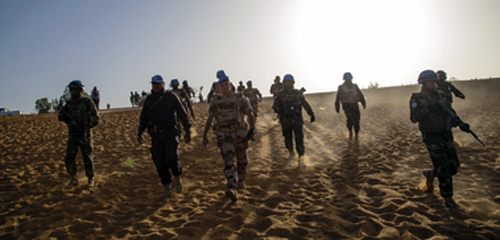
The security situation is evolving rapidly in West Africa and the Sahel—and worsening in places. The region has already featured quite prominently in the news in the first quarter of 2018. There has been another mass abduction of girls by the Islamist group, Boko Haram, in Nigeria, then an attack in Ouagadougou, Burkina Faso’s capital, against the army’s headquarters and the French embassy.
And then there was the release of a video documenting the attack against American green berets in Niger last October, which resulted in the first American military casualties in the country. Those are just the incidents that grabbed the most headlines.
The latest developments follow a very intense 2017. As well as continued incidents in the north, there was an upsurge in the number of attacks in central Mali, particularly in the Mopti region. Towns and military camps throughout the country, including in the south, suffered several sophisticated attacks. In October, the UN reported a more than 100% increase in the number of Islamist attacks since June. It identified the newly formed al-Qaeda umbrella group Jamaat Nusrat al-Islam wal Muslimeen as the prime culprit.
Jihadi violence has continued to spill into neighbouring countries, particularly in Niger and Burkina Faso. Those countries face both local jihadi movements such as Burkinabe Ansarul al Islam, and an array of other security challenges. Those include violent jihadi extremists with links to both al-Qaeda and Islamic State (IS), as well as criminal networks (especially human smuggling—Niger is a key transit hub).
Niger also remained preoccupied with its southern region as Niger, Nigeria, Chad and Cameroon contended with the enduring threat of Boko Haram. A combined military response, the Multinational Joint Task Force (MJTF), significantly weakened the insurgents and forced them to operate in a much smaller area (mainly in Nigeria’s Borno state).
Yet, from October 2017 a resurgence of attacks in the Nigerian states of Yobe and Adamawa, and in northern Cameroon, threw into question the effectiveness of the counterterrorism (CT) and counterinsurgency missions. Attacks expanded to states that had been virtually untouched to that point, such as Taraba and Edo. Female and child suicide attacks, improvised explosive devices, village raids and ambushes against the military were recurrent features. Boko Haram frequently attacked convoys and helicopters delivering aid to internally displaced people.
The regional dimension of the challenges has translated into region-wide responses, making the Sahel a highly militarised region. In addition to the UN Multidimensional Integrated Stabilization Mission in Mali, the region-wide Operation Barkhane and the MJTF in the Lake Chad Basin, last year saw the creation and first deployment of the G5 Sahel Force. That force is a welcome addition to the array of efforts to fight terrorism and human trafficking in the region. However, it faces several challenges, not least that of sustainability given its high dependence on Western financing.
Continued jihadist activity across the region in 2017 followed some established patterns. First, jihadi groups continued to fragment, scatter geographically and undergo ad hoc mergers. Second, al-Qaeda and IS leaders exploited the overlap between broader jihadist agendas and local drivers and grievances to recruit new members.
In operational CT, progress was made by capturing militants, retaking control of villages that had fallen prey to jihadists and introducing a host of new measures, including judicial agreements to facilitate the prosecution of suspected terrorists.
However, it was also evident that progress can be undermined by gross mistakes and misconduct on the part of security forces and governments that need to regain the trust of their citizens. Renewed trust would facilitate information exchanges about terrorist activities and reduce the groups’ popular support.
The transnational nature of the threat and the inability of many individual nation-states to fight that threat highlighted the importance of regional and international collaboration. That, however, shouldn’t overshadow the need to understand local dimensions. This notion was particularly evident in the case of jihadist activity in Burkina Faso’s Soum Province.
All jihadi groups active in the region have exploited, to varying but substantial degrees, discontent about poverty, the lack of employment and education, and political marginalisation. With that in mind, it’s encouraging that countries such as Nigeria and Burkina Faso are releasing funds to promote economic development in regions at risk of radicalisation and violent extremism.
However local communities also require government assurances and support if they’re expected to welcome large numbers of former hostages, as well as former fighters who are seen as potential security threats. Short of that, tensions seem inevitable, particularly as residents in many host communities are short of food and water.

